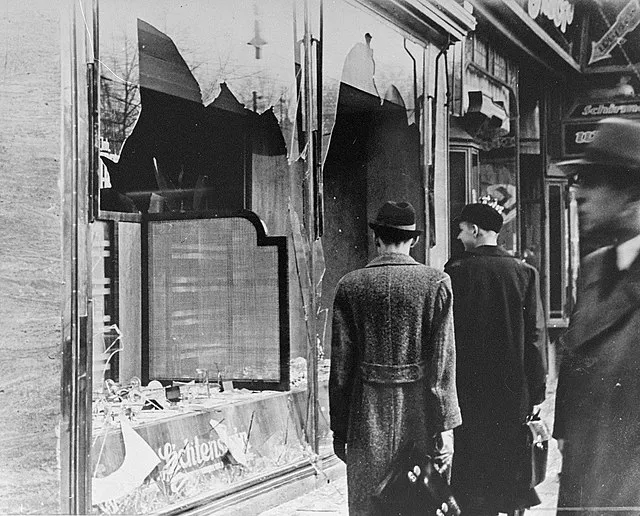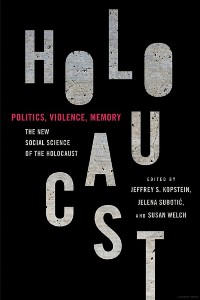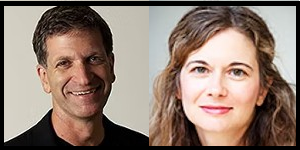Volume Examines the New Social Science of the Holocaust

We live in a culture profoundly influenced by the legacy of the Holocaust. More than seven decades after the fact, the Nazi extermination effort against the world’s Jews continues to provide the moral lens through which we judge political action. Debates about humanitarian intervention and foreign policy, democracy and authoritarianism, the politics of race, refugees, migration, and citizenship, and perhaps most importantly, our understanding of political violence have taken shape in the shadow of the destruction of European Jewry. The very categories we deploy to think about these matters—the most famous example being the concept of genocide—were developed in an attempt to understand the magnitude of what had occurred and to prevent anything like it from happening again.

The Holocaust functions therefore as a “shadow case” of sorts, a yardstick against which to compare a broad range of contemporary social and political processes. And yet, despite the centrality of the Holocaust to the way social scientists think about today’s world, the study of the “event” itself and its aftermath has remained largely peripheral to the social sciences, such as economics, geography, political science, sociology, and psychology. Our recently published book, Politics, Memory, Violence: The New Social Science of the Holocaust (edited together with the late Susan Welch) aims to integrate the insights of modern social science with Holocaust studies.
In the immediate aftermath of World War II, several social scientists wrote groundbreaking volumes on what we now term the Holocaust. Eugene Kogan (1950) trained as a sociologist and economist, published the Theory and Practice of Hell, an examination of Nazi concentration camps based on his own six years of imprisonment at Buchenwald. In 1961, Raul Hilberg, an Austrian-born American political scientist who had been stationed in Germany after the war, published The Destruction of the European Jews, a pioneering work that focused on the administrative and organizational structures that led to mass murder. Jewish refugees from Germany and Austria led the collaboration that resulted in The Authoritarian Personality, the influential work on the formation of antisemitism and individual-level authoritarian orientations that were understood to underpin the Nazi regime. That book by the sociologists and psychologists Theodor Adorno, Else Frenkel-Brunswick, Daniel Levinson, and Nevitt Sanford has been cited nearly 20,000 times and remains influential today. Allport’s, Milgram’s, and Zimbardo’s classic works in psychology were also responses to the Holocaust and properly belong to this generation.
Sometime after 1960, however, social science contributions became scarce. What explains the reluctance of social scientists to write on the Holocaust during this period? Any answer to this is necessarily speculative, but we maintain in the book that a first factor was the reluctance among Jewish social scientists to pigeonhole themselves into a topic that was “too Jewish” and therefore of secondary intellectual interest to the “big questions” of development and democracy. Second, social science itself had become increasingly theoretical and technical, focused on empirical generalization, methodology, and prediction. What was the Holocaust a case of? “Genocide” was one answer, and several important works elaborated on this theme. But the label also had its drawbacks, not only because the number of genocides is thankfully small, which inhibits testing of competing hypotheses, but also because genocide at its very core focused attention on the endpoint, the mass killing, rather than on the multiple processes that led there. The Holocaust was a genocide, but it was much more than that.

An important break in the logjam came with the paradigm shift from seeing the Holocaust as “one big thing” to examining it as a series of events. By viewing the Holocaust this way, social scientists now compare across localities and nations, across time, across administrative structures, population types, historical patterns, and many other conditions. This approach has facilitated an understanding of the factors that exacerbated or mitigated violence and death and has provided a powerful tool in accounting for the variation in the long-term impact of the Holocaust in different communities.
Consider Robert Braun’s contribution to our volume, a study of the determinants of antisemitism in the Weimar Republic. A large body of work has examined the subnational variation in xenophobia. It frequently focuses on how political and economic threats posed by outsiders translate into xenophobia among insiders. The support for both of these factors, Braun notes, is mixed. Instead, he moves to the macro-level emphasizing the importance of geo-political fears, maintaining that spatial variation in antisemitism in Weimar Germany was driven in part by territorial loss due to military defeat. Two mechanisms provide the link between territorial loss and hostility to “outsiders.” First territorial loss hardens ethnic fault lines, unleashing aggressive forms of nationalism. Second, geopolitical decline activates a sense of loss that generates exclusionary responses. These feelings and fault lines provide the environment in which those residing in the state but considered outside the ethnic community become scapegoats for all sorts of social problems.
In order to develop and test this hypothesis, Braun offers us a new dataset that examines geographic and temporal variation in antisemitic attitudes using the research conducted by folklorists. He tracks antisemitism in over 19,000 localities looking for the prevalence of Jewish bogeymen in Kinderschreck (children’s fright stories), which adults deployed to induce obedience in children. Using spatial econometrics and a difference-in-differences design, Braun shows, even controlling for a remarkable range of confounders and controls, that the regions proximate to territories stripped from Weimar Germany became the genuine hotbeds of antisemitism. Apart from the original use of ethnographic data that should inspire students of historical political economy in other contexts, Braun’s analysis offers a fascinating solution to a tricky problem: how best to measure antisemitism? Some scholars measure it by counting the frequency of antisemitic violence (such as pogroms), but they usually then explain the occurrence of pogroms by antisemitism, a case of clearly circular logic. Others look for the vote for antisemitic parties in a given locality, but this too has its pitfalls because voters may vote for antisemitic parties for reasons that have nothing to do with Jews; likewise, voters who are otherwise strongly antisemitic may vote for non-antisemitic parties for other reasons. Braun’s insight and method opens up the study of historical xenophobia that others will surely emulate.

A second good example is the work of Daniel Solomon, showcased in his chapter “Pogrom Violence and Visibility during the Kristallnacht Pogrom.” A great deal of work in the social sciences has focused on riots, pogroms, and lynching in other contexts, but little has been done on the first mass case of violence and property destruction within Nazi Germany itself. Solomon begins with a puzzle: why did participants in the Kristallnacht pogrom in November 1938 refrain from damaging or destroying one-third of the active synagogues in Germany? The political context of the time would not have predicted restraint. On November 9, Joseph Goebbels called on state officials assembled in Munich to engage in widespread violence against Jews throughout Germany. Yet, about a third of German communities was spared. Why?
He first offers a set of competing theories that students of intercommunal violence in other settings will find legible and important for their own comparative work. Then, using a new dataset on Kristallnacht pogroms, Solomon demonstrates that violence was most severe and most likely in communities where the Jewish population share was largest, in other words, where Jews were socially visible. He also finds the greatest number of synagogues were attacked in those localities where there was also a high concentration of Weimar-era electoral support for the German Communist Party. The more Jews and communist support in a town, the worse the Jewish community fared. Such findings put the study of the Holocaust into direct dialogue with work on lynching in the American south and Hindu-Muslim Violence in India, to name only a few locations.
Volha Charnysh turns our attention to the memory of the Holocaust and its impact on contemporary politics in her chapter “Remembering Past Atrocities: Good or Bad for Attitudes toward Minorities?” Commemorating violence is often considered important for promoting reconciliation, improving attitudes toward (and treatment of) ethnic minorities, and, perhaps most crucially, preventing repetition of violence in the future. But does commemoration actually produce these results? Far-right parties often question the Holocaust and almost always downplay or deny their nation’s wrongdoing during the war.
Using a survey experiment, Charnysh addresses the Polish case of memory politics. During World War II nearly all of the country’s 3.3 million Jews were killed. The local Christian population sometimes took advantage of the Jews’ plight, turning violently against their Jewish neighbors and looting their property. In her online survey experiment, Charnysh’s respondents were randomly assigned to narratives of well-known episodes of violence and then answered questions about their affective attachment to the nation, attitudes toward outgroups, and minority protection. The control group read about the 1995 massacre in Bosnia. One of the treated groups also read about the 1943 massacre in Volhynia of Poles at the hands of Ukrainians, with a priming note that the Polish suffering received less publicity than Jewish suffering in Jedwabne (the massacre of Jews by Poles in 1941). This treatment mirrors the strategy of the Polish right, which elevates national victimhood to counter criticism of Poles during the Holocaust.
Charnysh’s analysis shows that referencing in-group wrongdoing in the past becomes less effective and may even backfire in combating xenophobia and discrimination in the presence of competing victimhood narratives. Priming that highlights in-group crimes (the massacre of Jews by Poles in Jedwabne) reduced ethnocentric beliefs and collective narcissism, yet introducing competing victimhood narratives (the massacre of Poles by Ukrainians in Volhynia) offset this positive effect. The victimhood narrative that is routinely used by Polish politicians to diminish attention on in-group wrongdoing, dampened support for minority rights. With these and other results, Charnysh contributes to the broader literature demonstrating that the past is not transmitted to the present in an unmediated fashion; the past is, above all, “how we remember it.”
Each of the chapters in this volume offers analogous sorts of evidence and similar sort of unexpected insights. Although much work remains to be done in order to integrate the study of the Holocaust—the index case of violence in the modern world–into the mainstream of social science, it is our hope that this volume brings the conversation to a new level by highlighting how new questions and new data can illuminate this tragic set of events.
































































































